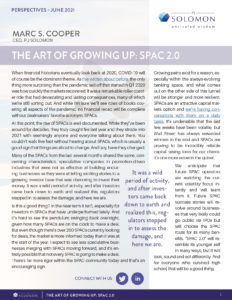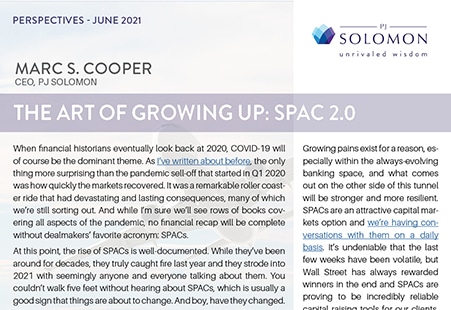 The Art of Growing Up: SPAC 2.0
The Art of Growing Up: SPAC 2.0
When financial historians eventually look back at 2020, COVID-19 will of course be the dominant theme. As I’ve written about before, the only thing more surprising than the pandemic sell-off that started in Q1 2020 was how quickly the markets recovered. It was a remarkable roller coaster ride that had devastating and lasting consequences, many of which we’re still sorting out. And while I’m sure we’ll see rows of books covering all aspects of the pandemic, no financial recap will be complete without dealmakers’ favorite acronym: SPACs.
At this point, the rise of SPACs is well-documented. While they’ve been around for decades, they truly caught fire last year and they strode into 2021 with seemingly anyone and everyone talking about them. You couldn’t walk five feet without hearing about SPACs, which is usually a good sign that things are about to change. And boy, have they changed.
Many of the SPACs from the last several months shared the same, concerning characteristics: speculative companies in promotion-driven industries that were not as effective at building enduring businesses as they were at telling exciting stories to a growing investor base that was clamoring to invest their money. It was a wild period of activity, and after investors came back down to earth and realized this, regulators stepped in to assess the damage, and here we are.
Is this a good thing? In the near-term it isn’t, especially for investors in SPACs that have underperformed lately. And it’s hard to see the pendulum swinging back overnight, given how many SPACs are on the clock to make a deal. But even though there’s over 200 SPACs currently looking for deals, the market is more informed today than it was at the start of the year. I expect to see less speculative businesses merging with SPACs moving forward, and it’s entirely possible that not every SPAC is going to make a deal. There’s far more rigor within the SPAC community today and that’s an encouraging sign.
Growing pains exist for a reason, especially within the always-evolving banking space, and what comes out on the other side of this tunnel will be stronger and more resilient. SPACs are an attractive capital markets option and we’re having conversations with them on a daily basis. It’s undeniable that the last few weeks have been volatile, but Wall Street has always rewarded winners in the end and SPACs are proving to be incredibly reliable capital raising tools for our clients. It’s one more arrow in the quiver.
We anticipate that future SPAC operators are watching the current volatility focus intently and will learn from it. Future SPAC success stories will revolve around businesses that very likely could go public via IPOs but will choose the SPAC route for its many benefits. “SPAC 2.0” will resemble its younger self in many ways, but it will look, sound and act differently. And for everyone who survived high school, that will be a good thing.
View PDF


